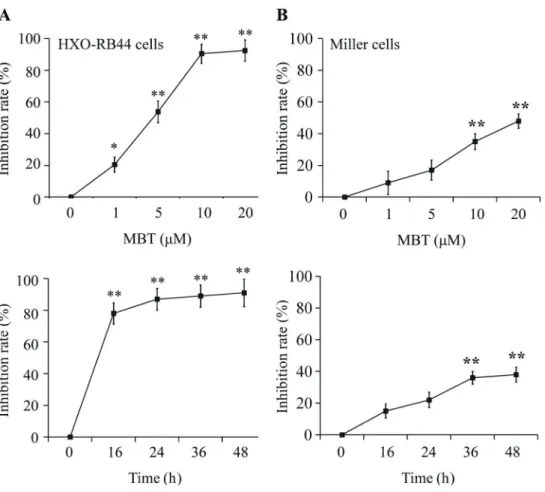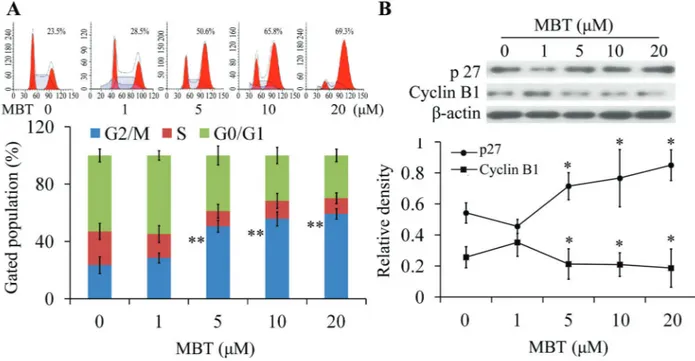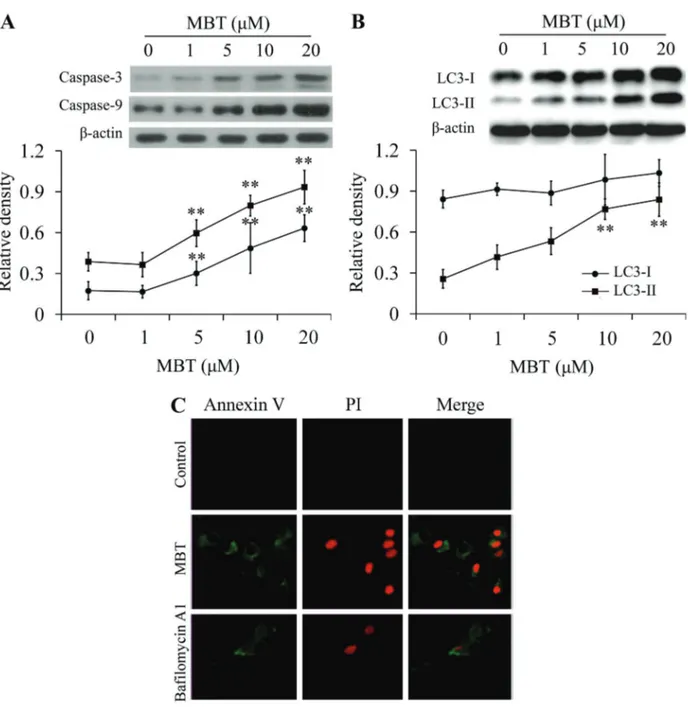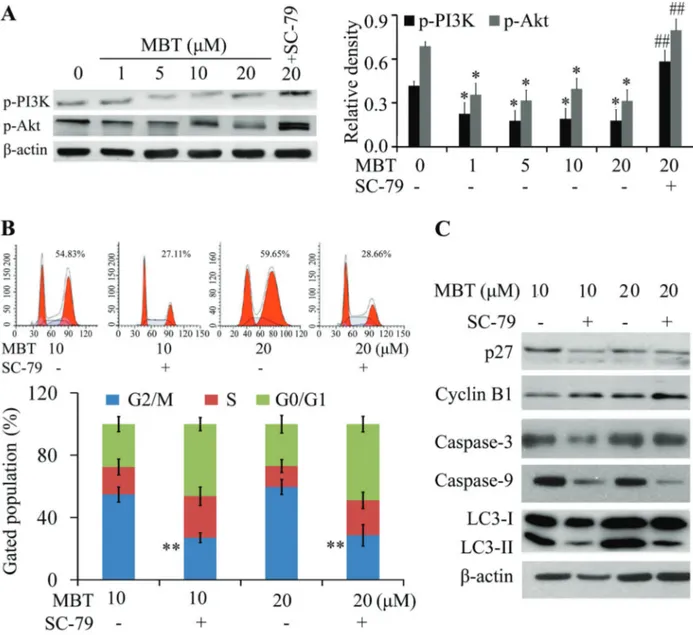2-Methyl 2-butanol suppresses human retinoblastoma
cells through cell cycle arrest and autophagy
Xiangyun Li
1, Xiangxiang Zhu
2, Chong Xu
1and Jianhua Wu
1 1Department of Fundus, Wuhan Aier Eye Hospital, Wuhan, Hubei Province, China 2Ophthalmology Center, Renmin Hospital of Wuhan University, Wuhan, Hubei Province, ChinaAbstract
2-Methyl-2-butanol (MBT) is a chemical compound from the group of alcohols more specifically pentanols, which has shown an excellent anti-cancer activity in our previous study. However, its mechanism of action remains unclear. The present study was designed to investigate the anti-cancer effect of MBT on human retinoblastoma cells. The results showed that the use of MBT leads to HXO-RB44 cell death but is cytotoxic to normal cells at higher concentrations. It showed a dose- as well as a time-dependent inhibition of HXO-RB44 cells. P27 is a cell cycle inhibitory protein, which plays an important role in cell cycle regulation whereas cyclin-B1 is a regulatory protein involved in mitosis. MBT increased the cell cycle arrest in a dose-dependent manner by augmenting p27 and reducing cyclin B1 expression. Moreover, it also accelerated apoptosis, increased light chain-3 (LC-3) conversion in a dose-dependent manner, and helped to debulk cancerous cells. LC3 is a soluble protein, which helps to engulf cytoplasmic components, including cytosolic proteins and organelles during autophagy from autophagosomes. In order to verify the effect of MBT, bafilomycin A1, an autophagy inhibitor, was used to block the MTB-induced apoptosis and necrosis. Additionally, a specific Akt agonist, SC-79, reversed the MBT-induced cell cycle arrest and autophagy. Thus, from the present study, it was concluded that MBT induced cell cycle arrest, apoptosis and autophagy through the PI3K/Akt pathway in HXO-RB44 cells. Key words: 2-methyl-2-butanol; Retinoblastoma; Cell cycle arrest; Autophagy; Phosphoinositide 3-kinase (PI3K)/Akt
Introduction
Retinoblastoma is a pediatric cancer of the retina most often caused by inactivation of the retinoblastoma tumor suppressor gene. It is a serious health problem as well as a threat to life. It is caused by a hereditary genetic defect as well as congenital mutation in the chromosome 13. Though most children survive this cancer, they may lose their vision in the affected eye or need to have the eye removed. There are various risk factors such as age, gene-tics, environment, and lifestyle, which affects the incidence of retinoblastoma in the world. According to World Health Organization statistics, retinoblastoma is more common in infants and very young children than in older children, which has aroused widespread attention in the medical profession (1). There are various treatment modalities for retinoblastoma including surgical treatment, radiation ther-apy, chemotherther-apy, and molecular targeted therapy (2,3). Treatments inhibit tumor growth but have few effects on reducing the mortality of patients with advanced cancer.
The initiation of cell cycle arrest, apoptosis and autoph-agy are the important strategies in cancer treatment as well as prevention. The cell cycle is the series of events that take place in a cell leading to its division to produce two daughter cells. Apoptosis is a process of programmed
cell death that occurs in multicellular organisms. Autoph-agy is the natural, regulated, destructive mechanism of the cell that disassembles unnecessary components. Various studies highlight that the therapeutic agents to treat cancer act by inhibiting cell cycle, apoptosis, and autophagy (4,5). These agents affect the cell cycle and cause autophagy through multi-signaling pathways within the cells. The PI3K/AKT/mTOR pathway is an intracellular signaling pathway important for regulating the cell cycle, autophagy, cell survival, proliferation, differentiation, apop-tosis, metabolism, and quiescence (6,7). The abnormal P13K/ AKT/mTOR signaling pathway leads to reduce apoptosis and increase proliferation and is the main cause of cell carcinogenesis, tumor invasion, metastasis, and drug resis-tance. The abnormalities of this signaling pathway are com-mon in breast cancer, lung cancer, liver cancer, melanoma, cervical cancer, and rhabdomyosarcoma (8–12). Therefore,
the investigation of P13K/AKT signaling pathway in retino-blastoma cells would be helpful to develop a new strategy to treat retinoblastoma.
2-Methyl-2-butanol (MBT) is a branched pentanol. It is a colorless flammable liquid with a pungent odor of camphor, used primarily as a pharmaceutical or pigment
Correspondence: Xiangyun Li:<xiangyunliphd@126.com>
solvent and as a raw material for synthetic perfumes and pesticides. MBT is also found in a variety of traditional Chinese medicines. In recent years, MBT has drawn more attention because of its wide use in industry, agriculture and medicine. Our previous study reported that MBT has anticancer properties under low concentration in HXO-RB44 cells. Moreover, it can be conveniently used in the eye for treatment of retinoblastoma. However, the detailed mechanisms of MBT action for the treatment of retino-blastoma are not well understood.
The present study was designed to investigate the anti-cancer effect as well as the molecular mechanisms of MBT to induce cell cycle arrest and autophagy in HXO-RB44 human retinoblastoma cells.
Material and Methods
MTT assay
We used the HXO-RB44 retinoblastoma cell line in this study. These cells were obtained from Sciencell Research Laboratories (USA). Primary normal retinal Miller cells were purchased from Meiyan Biotechnology (China). The cells
were cultured with L-glutamine and sodium pyruvate in Dulbecco’s Modified Eagle’s medium (DMEM; Sciencell Research Laboratories) with supplementation of 12% inactivated fetal bovine serum (FBS), 100 U/mL penicillin, and 100 mg/mL streptomycin at 37°C and 5% CO2. MBT
was obtained from Yancheng China Biotechnology Co. Ltd. (China). The HXO-RB44 and Miller cells were seeded onto 96-well plates (104cells) and treated with MBT (0, 1, 5, 10, and 20mM) for 16, 24, 36, and 48 h. MTT (0.5 mg/mL) was then added to each well for 3 h. Then, 500mL of DMSO was added to dissolve the crystals. The absorption values were determined at 540 nm with an ELISA plate reader.
Cell cycle assay
The HXO-RB44 cells were plated at a concentration of 106cells/well in 6-well plates and incubated with MBT
at 0, 1, 10, and 20 mM for 24 h. Then, the cells were collected and washed with cold PBS. Afterwards, cells were centrifuged at 500gfor 10 min at room temperature and the pellet wasfixed in 75% ethanol for 1 h at 4°C for PI (propidium iodide) staining. Then, the cells were washed with cold PBS and re-suspended in cold PI solution (50mg/mL)
containing RNase A (0.1 mg/mL) in PBS, pH 7.4, for 30 min in the dark.
Cell apoptosis and necrosis
Annexin V and PI double fluorescent staining was performed to detect cell apoptosis and necrosis. Normal living cells and early apoptotic cells resist staining by PI, but necrotic cells are stained. Briefly, HXO-RB44 cells were cultured in medium with or without MBT (20 mM). After 48 h of treatment, cells were washed twice with 0.01 M PBS and suspended in 200mL binding buffer. Cells were then incubated with 10mL Annexin V-FITC and 5mL PI for 30 min at 4°C in dark room. Annexin V-FITC and PI fluorescence was immediately observed under confocal laser scanning microscope (Olympus, Japan). Bafilomycin A1 (autophage inhibitor) with afinal concentration of 10mM was used to examine the MBT-induced autophage.
Western blot analysis
The HXO-RB44 cells were first seeded onto 6-well plates (106cells/well) and then treated with MBT at 0, 1, 10, and 20mM for 24 h. Total cell lysates were obtained after treatment with RIPA buffer and protease inhibitors. The protein concentrations were determined by Bradford protein assay (BioRad Lab., USA). Approximately 75mg of lysate was resolved on 12% SDS-PAGE, electrotransferred to PVDF membranes (Dingguo, China), and then incubated with specific primary rabbit polyclonal antibodies to cyclin B1, p27, and caspase-3 at 4°C overnight. Caspase-9, LC3-I LC3-II, p-PI3K, and p-Akt were purchased from Abcam,
Shanghai, China. Antibody againstb-actin and peroxidase-labeled anti-rabbit immunoglobulin were purchased from Boster (China) and an enhanced chemiluminescence (ECL) kit was purchased from Pierce (USA).
PI3K/Akt agonist
To identify the role of PI3K/Akt on MBT-induced cell cycle arrest and autophagy in HXO-RB44 cells, 10mM of SC79 (a specific Akt agonist) was pretreated 1 h before MBT (10 or 20mM) treatment. SC79 was purchased from AMQUAR Life Science & Biotechnology (China). The further experiments were conducted after incubation with MTB for 24 h.
Statistical analysis
Data are reported as means±SD. Significant
differ-ences were determined using one-way ANOVA for multi-ple group comparison and Student’st-test for two group comparison. Po0.05 was considered statistically significant.
Results
MBT inhibited HXO-RB44 cell viability
The results of the experiment showed that MBT sig-nificantly inhibited the proliferation of HXO-RB44 cells in a dose- and time-dependent manner where 50% inhibitory concentration (IC50) was estimated approximately at 5mM (Figure 1A and B). However, MBT had low cytotoxicity to Miller cells. Thesefindings suggested that MBT had greater cytotoxicity to HXO-RB44 cells.
MBT induced cell cycle arrest in HXO-RB44 cells
The cells in the G2/M phase were significantly increased in a dose-dependent manner (Figure 2A). Western blot results showed that the p27 and cyclin B1 proteins are crucial in G2/M phase transition process. The results revealed that MBT increased p27 expression and decreased the expression levels of cyclin B1 protein in a dose-dependent manner at 24 h treatment (Figure 2B). These data suggested
that MBT induced cell cycle arrest by regulation of p27 and cyclin B1 proteins in HXO-RB44 cells.
MBT induced cell apoptosis and autophagy in HXO-RB44 cells
Apoptosis markers caspase-3 and caspase-9 and autoph-agy markers microtubule-associated protein1 light chain 3 (LC3) were analyzed by western blot. The results showed
that MBT induced apoptosis in a dose-dependent manner (Figure 3A). During autophagy, a cytosolic form of LC3 (LC3-I) is conjugated to phosphatidylethanolamine to form membrane-bound form of LC3 (LC3-II). In this study, two variants of LC3 were detected by western blot and the ratio of LC3-II/LC3-I also showed an increase in a dose-dependent manner (Figure 3B). Thus, the results sug-gested that MBT induced autophagy by promoting the conversion of LC3-I to LC3-II.
The results for apoptosis and necrosis markers Annexin V-FITC and PI double fluorescence staining showed that Annexin V-FITC and PI signals could barely
be detected in control cells, while strongfluorescence den-sities were visible in response to MBT (20mM); apoptosis and necrosis could be blocked by Bafilomycin A1 (auto-phage inhibitor; Figure 3C).
Involvement of PI3K/AKT pathway in MBT-induced effects
Western blot revealed that MBT inhibited the activation of p-PI3K and p-Akt (Figure 4A). SC-79 reversed the cell cycle arrest induced by MBT (Figure 4B). In addition, SC-79 (specific Akt agonist) decreased the expression of p27 and promoted the expression of cyclin B1 in the MBT-treated
HXO-RB44 cells. It was also found that SC-79 inhibited the MBT-induced apoptosis and autophagy (Figure 4C). Hence, these findings suggested that PI3K/Akt pathway was involved in MBT induced G2/M arrest and autophagy.
Discussion
Retinoblastoma is a common ocular cancer in children that rapidly develops from the immature cells of the retina. MBT is a branched pentanol, colorless, and flammable liquid. It is common in organic solvents and widely used in the food industry, agriculture, and medicine. It is also found in a variety of traditional Chinese medicines. In our previous study, it was found that MBT has anti-cancer activity but the mechanisms are not well understood. It was also found that apart from abnormal cells, MBT also damages normal cells at higher concentrations. The present study was designed to investigate the anti-cancer effect of MBT on human retinoblastoma cells. The results highlight that MBT induced cell cycle arrest, apoptosis and autophagy by suppression of PI3K/Akt pathways in HXO-RB44 cells. This is thefirst report showing the anti-cancer mechanisms of MBT in HXO-RB44 cells, which induced G2/M cycle arrest and autophagy through PI3K/Akt-mediated pathways.
The G2/M phase progression is controlled by cyclin B1 and CDK1 complex (13). Cyclin B is a mitotic cyclin and CDK1 is a highly conserved protein, which is a key player in cell cycle regulation. Cyclin-CDK1 phosphorylate proteins, which leads to cell cycle progression (14). The cyclin-dependent kinase (Cdk) inhibitor p27 is a cell cycle inhibitory protein that plays an important role in cell cycle arrest and hence inhibits cell proliferation. In our study, western blot results showed that MBT significantly in-creased p27 and dein-creased cyclin B1 protein expression in HXO-RB44 cells, which indicate that MBT-induced G2/M
arrest might be associated with down-regulation of cyclin B1 and CDK1 complex and up-regulation of p27.
Apart from G2/M arrest, MBT also induced apoptosis and autophagy. Caspase-9 is an initiator caspase while caspase 3 protein plays a central role in the execution phase of cell apoptosis (6). Caspase-9 and caspase-3 are located upstream and downstream of the apoptosis cas-cade, respectively. Caspase-3 is activated by caspase-9 (15). MBT could induce apoptosis in HXO-RB44 cells by activating the caspase-3 and -9. Moreover, light chain 3 (LC3) is a soluble protein that helps to engulf cytoplasmic components, including cytosolic proteins and organelles during autophagy by autophagosomes and is widely used as a biochemical marker of autophagy (16). A marked conversion of free LC3-I to heavier lipid bound LC3-II was detected by western blot where the ratio of LC3-II/ LC3-I increased in a dose-dependent manner. In addition, MBT could induce apoptosis and necrosis, which could be reversed by autophage inhibitor bafilomycin A1. In our experiment, MBT dephosphorylated PI3K and Akt signaling pathway. PI3K/AKT/mTOR pathway is an intracellular signaling pathway important in regulating cell cycle, proliferation and apoptosis. A specific Akt agonist reversed MBT-induced cell cycle arrest, apoptosis, and autoph-agy in HXO-RB44 cells. Hence, these findings sug-gested that PI3K/Akt signaling pathway was involved in MBT-induced effects of HXO-RB44 cells. Thus, PI3K/Akt pathways might contribute to the MBT-induced apoptosis and autophagy.
In the present study, we focused on the mechanisms of the anti-cancer effect of MBT on human retinoblas-toma cells to find a possible clinical application. Hence, we have demonstrated the anti-cancer mechanism for MBT-induced cell cycle arrest and autophagy in HXO-RB44 cells to be through inhibition of PI3K/Akt signaling pathway.
References
1. Bhargav A, Singh U, Trehan A, Zadeng Z, Bansal D. Female Sex, bilateral disease, age below 3 years, and apprehension for enucleation contribute to treatment abandonment in retinoblastoma.J Pediatr Hematol Oncol2017; 39: e249– e253, doi: 10.1097/MPH.0000000000000856.
2. Mendoza PR, Grossniklaus HE. Therapeutic options for retinoblastoma. Cancer Control 2016; 23: 99–109, doi: 10.1177/107327481602300203.
3. Grossniklaus HE. Retinoblastoma. Fifty years of progress. The LXXI Edward Jackson Memorial Lecture.Am J Ophthal-mol2014; 158: 875–891, doi: 10.1016/j.ajo.2014.07.025. 4. Li Y, Cui Y, Wang W, Ma M, Li M, Chen S. effect of the serum
inhibited gene (Si1) on Autophagy and apoptosis in MCF-7 breast cancer cells.Cell Physiol Biochem2017; 41: 2268– 2278, doi: 10.1159/000475644.
5. Visagie MH, van den Bout I, Joubert AM. A bis-sulphamoy-lated estradiol derivative induces ROS-dependent cell cycle
abnormalities and subsequent apoptosis.PLoS One. 2017; 12: e0176006, doi: 10.1371/journal.pone.0176006. 6. Kim SH, Son KM, Kim KY, Yu SN, Park SG, Kim YW, et al.
Deoxypodophyllotoxin induces cytoprotective autophagy against apoptosis via inhibition of PI3K/AKT/mTOR pathway in osteosarcoma U2OS cells. Pharmacol Rep 2017; 69: 878–884, doi: 10.1016/j.pharep.2017.04.007.
7. Kumar D, Das B, Sen R, Kundu P, Manna A, Sarkar A, et al. Andrographolide Analogue induces apoptosis and autophagy mediated cell death in U937 Cells by Inhibition of PI3K/Akt/ mTOR pathway.PLoS One2015; 10: e0139657, doi: 10.1371/ journal.pone.0139657.
9. Zhu H, Liu Q, Tang J, Xie Y, Xu X, Huang R, et al. Alpha1-ACT Functions as a tumour suppressor in hepatocellular carcinoma by inhibiting the pi3k/akt/mtor signalling pathway via activation of PTEN. Cell Physiol Biochem 2017; 41: 2289–2306, doi: 10.1159/000475648.
10. Caporali S, Alvino E, Lacal PM, Levati L, Giurato G, Memoli D, et al. Targeting the PI3K/AKT/mTOR pathway overcomes the stimulating effect of dabrafenib on the invasive behavior of melanoma cells with acquired resistance to the BRAF inhibitor.Int J Oncol2016; 49: 1164–1174, doi: 10.3892/ijo. 2016.3594.
11. Tsai JP, Lee CH, Ying TH, Lin CL, Lin CL, Hsueh JT, et al. Licochalcone A induces autophagy through PI3K/Akt/mTOR inactivation and autophagy suppression enhances Licochal-cone A-induced apoptosis of human cervical cancer cells. Oncotarget2015; 6: 28851–28866, doi: 10.18632/oncotar-get.4767.
12. Oudart JB, Doué M, Vautrin A, Brassart B, Sellier C, Dupont-Deshorgue A, et al. The anti-tumor NC1 domain of collagen XIX inhibits the FAK/PI3K/Akt/mTOR signaling pathway
throughavb3 integrin interaction.Oncotarget2016; 7: 1516– 1528, doi: 10.18632/oncotarget.6399.
13. de Gooijer MC, van den Top A, Bockaj I, Beijnen JH, Würdinger T, van Tellingen O. The G2 checkpoint-a node-based molecular switch.FEBS Open Bio2017; 7: 439–455, doi: 10.1002/2211-5463.12206.
14. Shi H, Li Y, Ren X, Zhang Y, Yang Z, Qi C. A novel quinazoline-based analog induces G2/M cell cycle arrest and apoptosis in human A549 lung cancer cells via a ROS-dependent mechanism. Biochem Biophys Res Commun 2017; 486: 314–320, doi: 10.1016/j.bbrc.2017.03.034. 15. Akashi E, Fujihara S, Morishita A, Tadokoro T, Chiyo T,
Fujikawa K, et al. Effects of galectin-9 on apoptosis, cell cycle and autophagy in human esophageal adenocarcinoma cells. Oncol Rep2017; 38: 506–514, doi: 10.3892/or.2017.5689. 16. Shen W, Zhang X, Fu X, Fan J, Luan J, Cao Z, et al. A novel



